Self Checkout Machines: Evolution, Business Applications and Impact
VerifiedAdded on 2023/06/10
|10
|2699
|237
Report
AI Summary
This report examines the role and impact of self-checkout machines in modern business. It begins by highlighting the importance of self-checkout systems in reducing overhead costs, enhancing productivity, and improving customer experience. The report traces the development of this technology from its inception in the early 1990s to its current widespread use in supermarkets and retail stores. It details the technological platforms and software utilized, including barcode scanners and RFID technology, and discusses how these machines are implemented in various business settings. The report further evaluates the effectiveness of self-service machines in improving in-store productivity, reducing queues, and minimizing losses. Finally, it connects the adoption of self-checkout technology to broader trends in digital transformation, artificial intelligence, and machine learning, emphasizing the importance of these technologies in enhancing business efficiency, customer satisfaction, and cybersecurity.

SELF CHECKOUT
MACHINES
MACHINES
Paraphrase This Document
Need a fresh take? Get an instant paraphrase of this document with our AI Paraphraser
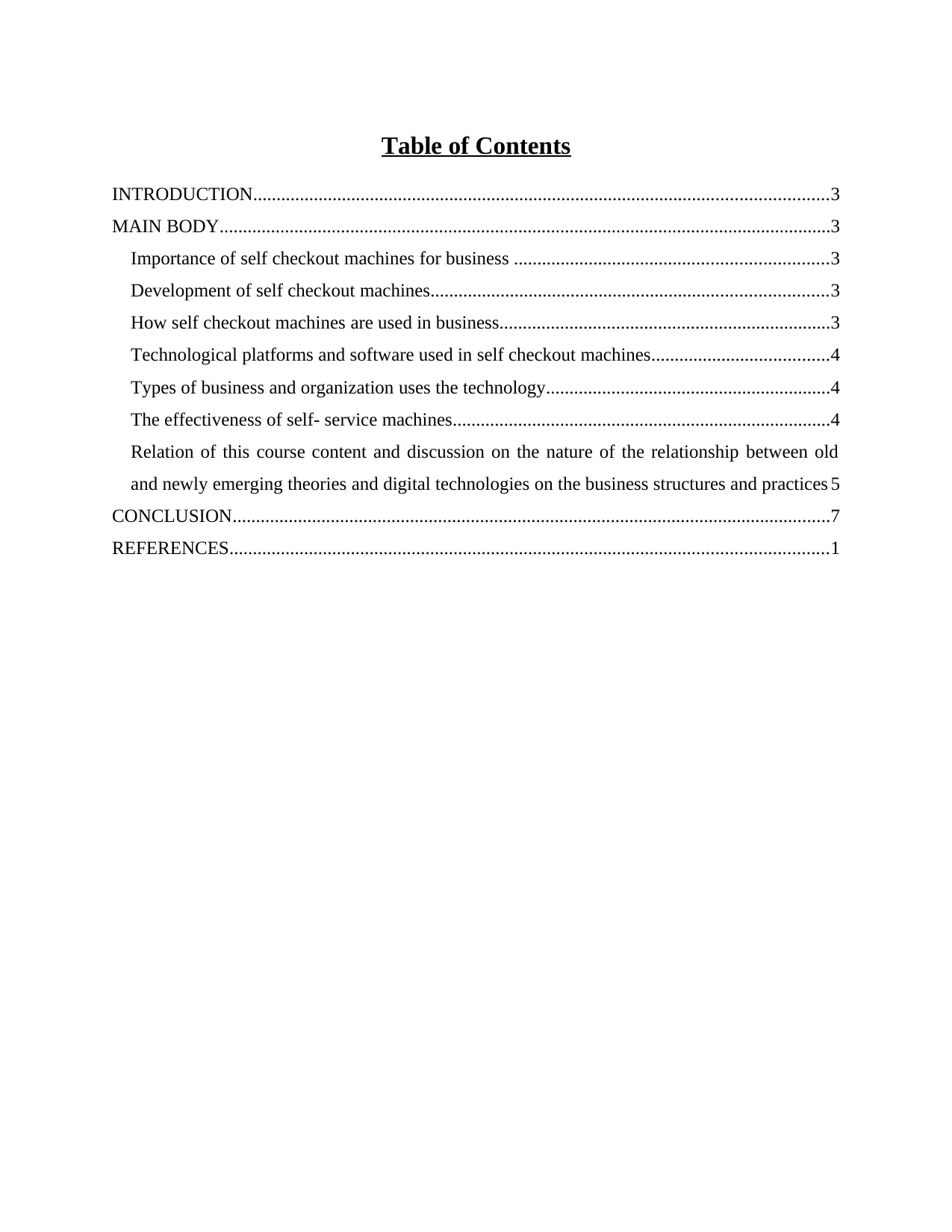
Table of Contents
INTRODUCTION...........................................................................................................................3
MAIN BODY...................................................................................................................................3
Importance of self checkout machines for business ...................................................................3
Development of self checkout machines.....................................................................................3
How self checkout machines are used in business.......................................................................3
Technological platforms and software used in self checkout machines......................................4
Types of business and organization uses the technology.............................................................4
The effectiveness of self- service machines.................................................................................4
Relation of this course content and discussion on the nature of the relationship between old
and newly emerging theories and digital technologies on the business structures and practices 5
CONCLUSION................................................................................................................................7
REFERENCES................................................................................................................................1
INTRODUCTION...........................................................................................................................3
MAIN BODY...................................................................................................................................3
Importance of self checkout machines for business ...................................................................3
Development of self checkout machines.....................................................................................3
How self checkout machines are used in business.......................................................................3
Technological platforms and software used in self checkout machines......................................4
Types of business and organization uses the technology.............................................................4
The effectiveness of self- service machines.................................................................................4
Relation of this course content and discussion on the nature of the relationship between old
and newly emerging theories and digital technologies on the business structures and practices 5
CONCLUSION................................................................................................................................7
REFERENCES................................................................................................................................1
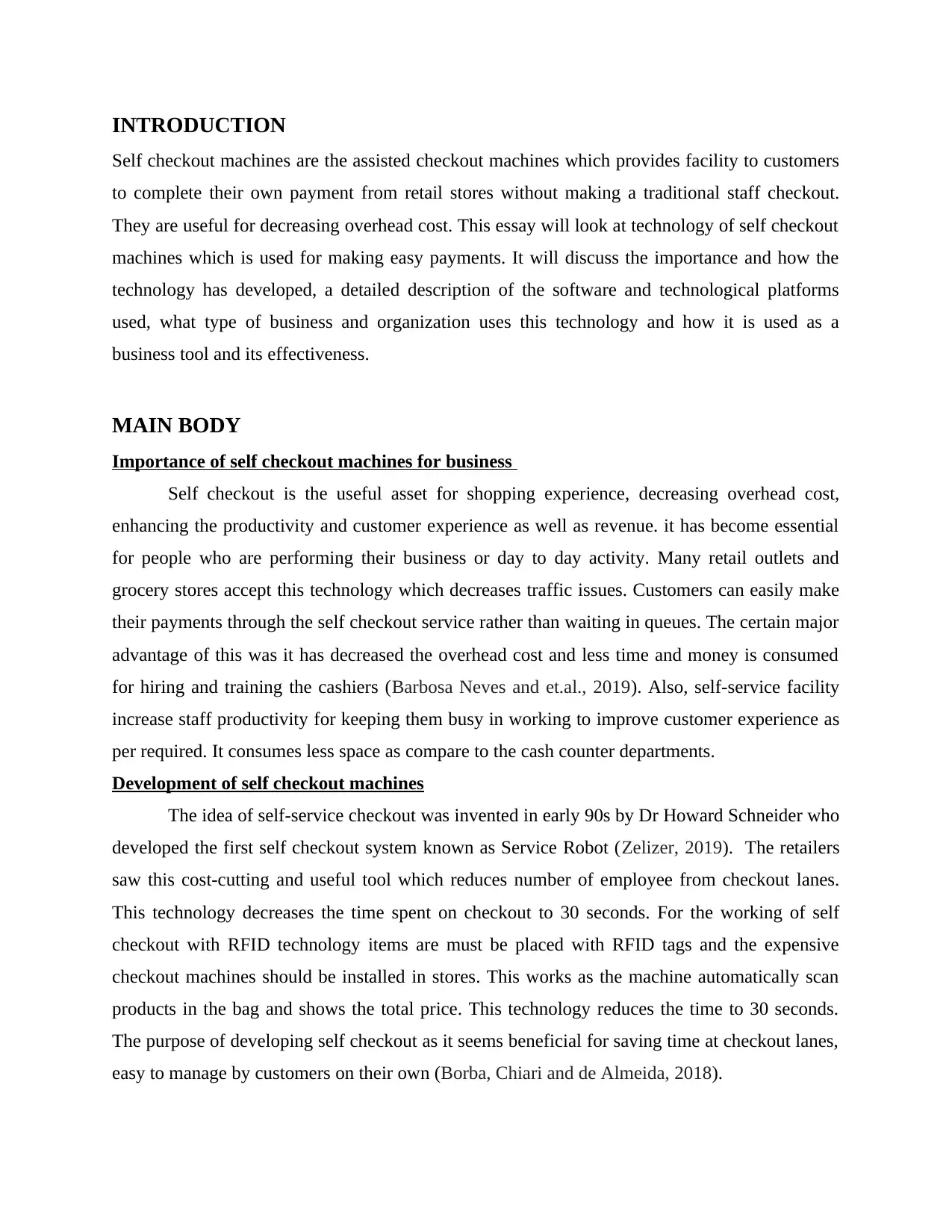
INTRODUCTION
Self checkout machines are the assisted checkout machines which provides facility to customers
to complete their own payment from retail stores without making a traditional staff checkout.
They are useful for decreasing overhead cost. This essay will look at technology of self checkout
machines which is used for making easy payments. It will discuss the importance and how the
technology has developed, a detailed description of the software and technological platforms
used, what type of business and organization uses this technology and how it is used as a
business tool and its effectiveness.
MAIN BODY
Importance of self checkout machines for business
Self checkout is the useful asset for shopping experience, decreasing overhead cost,
enhancing the productivity and customer experience as well as revenue. it has become essential
for people who are performing their business or day to day activity. Many retail outlets and
grocery stores accept this technology which decreases traffic issues. Customers can easily make
their payments through the self checkout service rather than waiting in queues. The certain major
advantage of this was it has decreased the overhead cost and less time and money is consumed
for hiring and training the cashiers (Barbosa Neves and et.al., 2019). Also, self-service facility
increase staff productivity for keeping them busy in working to improve customer experience as
per required. It consumes less space as compare to the cash counter departments.
Development of self checkout machines
The idea of self-service checkout was invented in early 90s by Dr Howard Schneider who
developed the first self checkout system known as Service Robot (Zelizer, 2019). The retailers
saw this cost-cutting and useful tool which reduces number of employee from checkout lanes.
This technology decreases the time spent on checkout to 30 seconds. For the working of self
checkout with RFID technology items are must be placed with RFID tags and the expensive
checkout machines should be installed in stores. This works as the machine automatically scan
products in the bag and shows the total price. This technology reduces the time to 30 seconds.
The purpose of developing self checkout as it seems beneficial for saving time at checkout lanes,
easy to manage by customers on their own (Borba, Chiari and de Almeida, 2018).
Self checkout machines are the assisted checkout machines which provides facility to customers
to complete their own payment from retail stores without making a traditional staff checkout.
They are useful for decreasing overhead cost. This essay will look at technology of self checkout
machines which is used for making easy payments. It will discuss the importance and how the
technology has developed, a detailed description of the software and technological platforms
used, what type of business and organization uses this technology and how it is used as a
business tool and its effectiveness.
MAIN BODY
Importance of self checkout machines for business
Self checkout is the useful asset for shopping experience, decreasing overhead cost,
enhancing the productivity and customer experience as well as revenue. it has become essential
for people who are performing their business or day to day activity. Many retail outlets and
grocery stores accept this technology which decreases traffic issues. Customers can easily make
their payments through the self checkout service rather than waiting in queues. The certain major
advantage of this was it has decreased the overhead cost and less time and money is consumed
for hiring and training the cashiers (Barbosa Neves and et.al., 2019). Also, self-service facility
increase staff productivity for keeping them busy in working to improve customer experience as
per required. It consumes less space as compare to the cash counter departments.
Development of self checkout machines
The idea of self-service checkout was invented in early 90s by Dr Howard Schneider who
developed the first self checkout system known as Service Robot (Zelizer, 2019). The retailers
saw this cost-cutting and useful tool which reduces number of employee from checkout lanes.
This technology decreases the time spent on checkout to 30 seconds. For the working of self
checkout with RFID technology items are must be placed with RFID tags and the expensive
checkout machines should be installed in stores. This works as the machine automatically scan
products in the bag and shows the total price. This technology reduces the time to 30 seconds.
The purpose of developing self checkout as it seems beneficial for saving time at checkout lanes,
easy to manage by customers on their own (Borba, Chiari and de Almeida, 2018).
⊘ This is a preview!⊘
Do you want full access?
Subscribe today to unlock all pages.

Trusted by 1+ million students worldwide
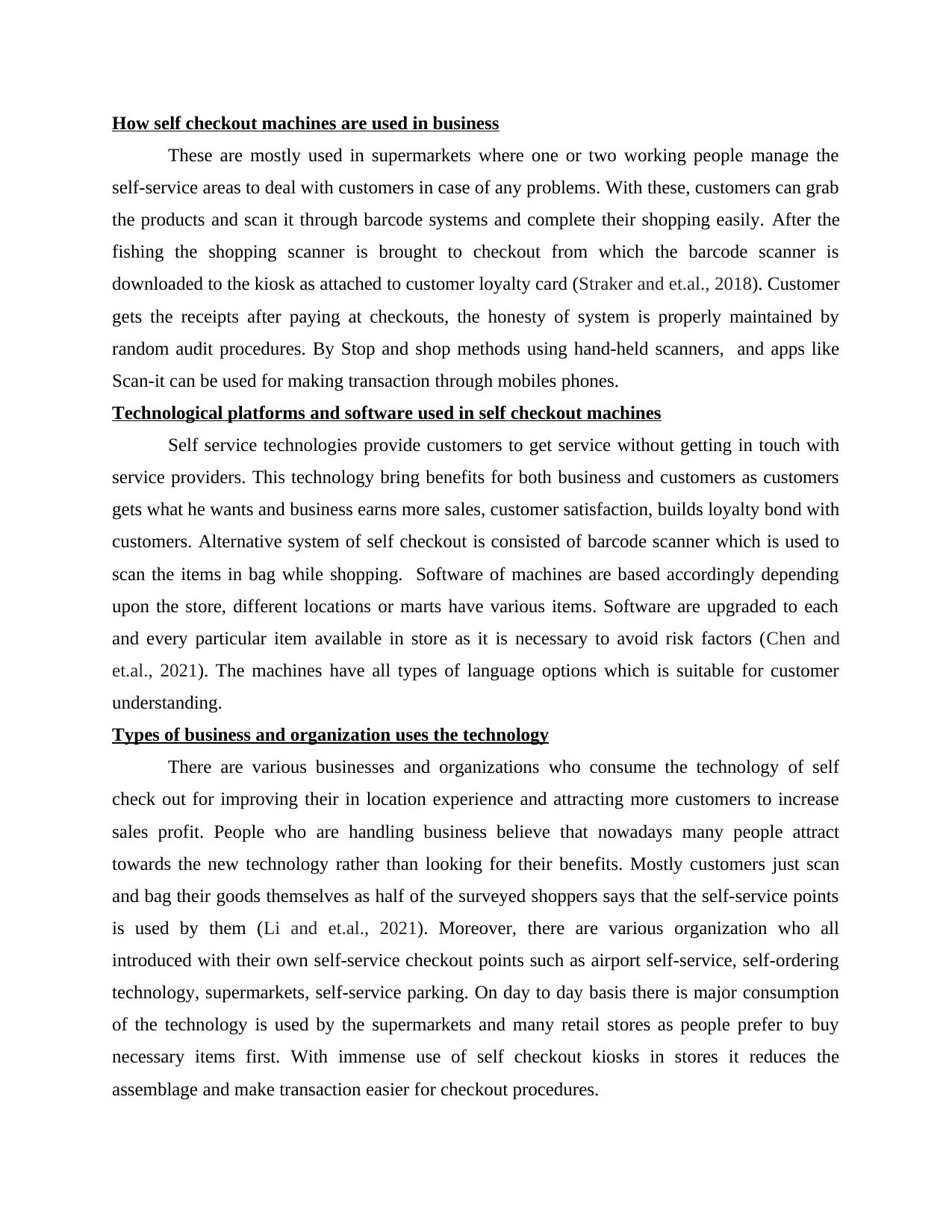
How self checkout machines are used in business
These are mostly used in supermarkets where one or two working people manage the
self-service areas to deal with customers in case of any problems. With these, customers can grab
the products and scan it through barcode systems and complete their shopping easily. After the
fishing the shopping scanner is brought to checkout from which the barcode scanner is
downloaded to the kiosk as attached to customer loyalty card (Straker and et.al., 2018). Customer
gets the receipts after paying at checkouts, the honesty of system is properly maintained by
random audit procedures. By Stop and shop methods using hand-held scanners, and apps like
Scan-it can be used for making transaction through mobiles phones.
Technological platforms and software used in self checkout machines
Self service technologies provide customers to get service without getting in touch with
service providers. This technology bring benefits for both business and customers as customers
gets what he wants and business earns more sales, customer satisfaction, builds loyalty bond with
customers. Alternative system of self checkout is consisted of barcode scanner which is used to
scan the items in bag while shopping. Software of machines are based accordingly depending
upon the store, different locations or marts have various items. Software are upgraded to each
and every particular item available in store as it is necessary to avoid risk factors (Chen and
et.al., 2021). The machines have all types of language options which is suitable for customer
understanding.
Types of business and organization uses the technology
There are various businesses and organizations who consume the technology of self
check out for improving their in location experience and attracting more customers to increase
sales profit. People who are handling business believe that nowadays many people attract
towards the new technology rather than looking for their benefits. Mostly customers just scan
and bag their goods themselves as half of the surveyed shoppers says that the self-service points
is used by them (Li and et.al., 2021). Moreover, there are various organization who all
introduced with their own self-service checkout points such as airport self-service, self-ordering
technology, supermarkets, self-service parking. On day to day basis there is major consumption
of the technology is used by the supermarkets and many retail stores as people prefer to buy
necessary items first. With immense use of self checkout kiosks in stores it reduces the
assemblage and make transaction easier for checkout procedures.
These are mostly used in supermarkets where one or two working people manage the
self-service areas to deal with customers in case of any problems. With these, customers can grab
the products and scan it through barcode systems and complete their shopping easily. After the
fishing the shopping scanner is brought to checkout from which the barcode scanner is
downloaded to the kiosk as attached to customer loyalty card (Straker and et.al., 2018). Customer
gets the receipts after paying at checkouts, the honesty of system is properly maintained by
random audit procedures. By Stop and shop methods using hand-held scanners, and apps like
Scan-it can be used for making transaction through mobiles phones.
Technological platforms and software used in self checkout machines
Self service technologies provide customers to get service without getting in touch with
service providers. This technology bring benefits for both business and customers as customers
gets what he wants and business earns more sales, customer satisfaction, builds loyalty bond with
customers. Alternative system of self checkout is consisted of barcode scanner which is used to
scan the items in bag while shopping. Software of machines are based accordingly depending
upon the store, different locations or marts have various items. Software are upgraded to each
and every particular item available in store as it is necessary to avoid risk factors (Chen and
et.al., 2021). The machines have all types of language options which is suitable for customer
understanding.
Types of business and organization uses the technology
There are various businesses and organizations who consume the technology of self
check out for improving their in location experience and attracting more customers to increase
sales profit. People who are handling business believe that nowadays many people attract
towards the new technology rather than looking for their benefits. Mostly customers just scan
and bag their goods themselves as half of the surveyed shoppers says that the self-service points
is used by them (Li and et.al., 2021). Moreover, there are various organization who all
introduced with their own self-service checkout points such as airport self-service, self-ordering
technology, supermarkets, self-service parking. On day to day basis there is major consumption
of the technology is used by the supermarkets and many retail stores as people prefer to buy
necessary items first. With immense use of self checkout kiosks in stores it reduces the
assemblage and make transaction easier for checkout procedures.
Paraphrase This Document
Need a fresh take? Get an instant paraphrase of this document with our AI Paraphraser

The effectiveness of self- service machines
With safety benefits, self-service provides various advantages. These are useful because
it inbuilt the in store productivity and shorter the queues as with self-service. Customers also take
interest in feature of selecting languages accordingly, so they can make their purchase without
hesitating. It fewer the losses as before 30 to 50 percent of losses were occurred due to theft or
human factors but at self-service there are no cash handling risks. Self checkout points carry less
space and it can handle more customers as compare to normal checkout (Lund and Tyson, 2018).
On the same level mostly stores can fit four time self-service which results in four time more
capacity. In effective terms retailers can bring the experience of making appreciated feeling to
the customer and with that experience they willingly come back.
Relation of this course content and discussion on the nature of the relationship between old
and newly emerging theories and digital technologies on the business structures and
practices
Business uses digital technology to add a value to business models, customer experiences
and capabilities which support core operations. In discussion, self-checkout machines are the
previous technology and it is upgrading with time. Digital brands and traditional players are
upgrading the business forward with use of digital technology (Sharma, Ueno and Kingshott,
2021). In the context of new technology it is beneficial for the business to conduct in systematic
way as technology is changing rapidly. The transformation has make business more efficient and
profitable, with digital technologies new ways of attracting the attention of customers can be
implemented and easy to adapt the market change also. Efficiency and productivity plays key
role in terms of digital transformation, it brings change in way of performing business as with
beginning of positive aspect on customer experiences, working operations, employee
engagement.
By following the process of AI and machine learning, artificial intelligence is term which
relates to computer software which engage human activities such as learning, planning and
problems solving. This allows business to improve the working process and free up employee
time with improving productivity (Mannheim and et.al., 2019). It is very broad way of moving
further with digital technology and there are also some upcoming changes which also arrives
with future aspects. Digital technology helps to grow further, as artificial intelligence is a
software which uses AI technology and special algorithms for managing different task. Self-
With safety benefits, self-service provides various advantages. These are useful because
it inbuilt the in store productivity and shorter the queues as with self-service. Customers also take
interest in feature of selecting languages accordingly, so they can make their purchase without
hesitating. It fewer the losses as before 30 to 50 percent of losses were occurred due to theft or
human factors but at self-service there are no cash handling risks. Self checkout points carry less
space and it can handle more customers as compare to normal checkout (Lund and Tyson, 2018).
On the same level mostly stores can fit four time self-service which results in four time more
capacity. In effective terms retailers can bring the experience of making appreciated feeling to
the customer and with that experience they willingly come back.
Relation of this course content and discussion on the nature of the relationship between old
and newly emerging theories and digital technologies on the business structures and
practices
Business uses digital technology to add a value to business models, customer experiences
and capabilities which support core operations. In discussion, self-checkout machines are the
previous technology and it is upgrading with time. Digital brands and traditional players are
upgrading the business forward with use of digital technology (Sharma, Ueno and Kingshott,
2021). In the context of new technology it is beneficial for the business to conduct in systematic
way as technology is changing rapidly. The transformation has make business more efficient and
profitable, with digital technologies new ways of attracting the attention of customers can be
implemented and easy to adapt the market change also. Efficiency and productivity plays key
role in terms of digital transformation, it brings change in way of performing business as with
beginning of positive aspect on customer experiences, working operations, employee
engagement.
By following the process of AI and machine learning, artificial intelligence is term which
relates to computer software which engage human activities such as learning, planning and
problems solving. This allows business to improve the working process and free up employee
time with improving productivity (Mannheim and et.al., 2019). It is very broad way of moving
further with digital technology and there are also some upcoming changes which also arrives
with future aspects. Digital technology helps to grow further, as artificial intelligence is a
software which uses AI technology and special algorithms for managing different task. Self-
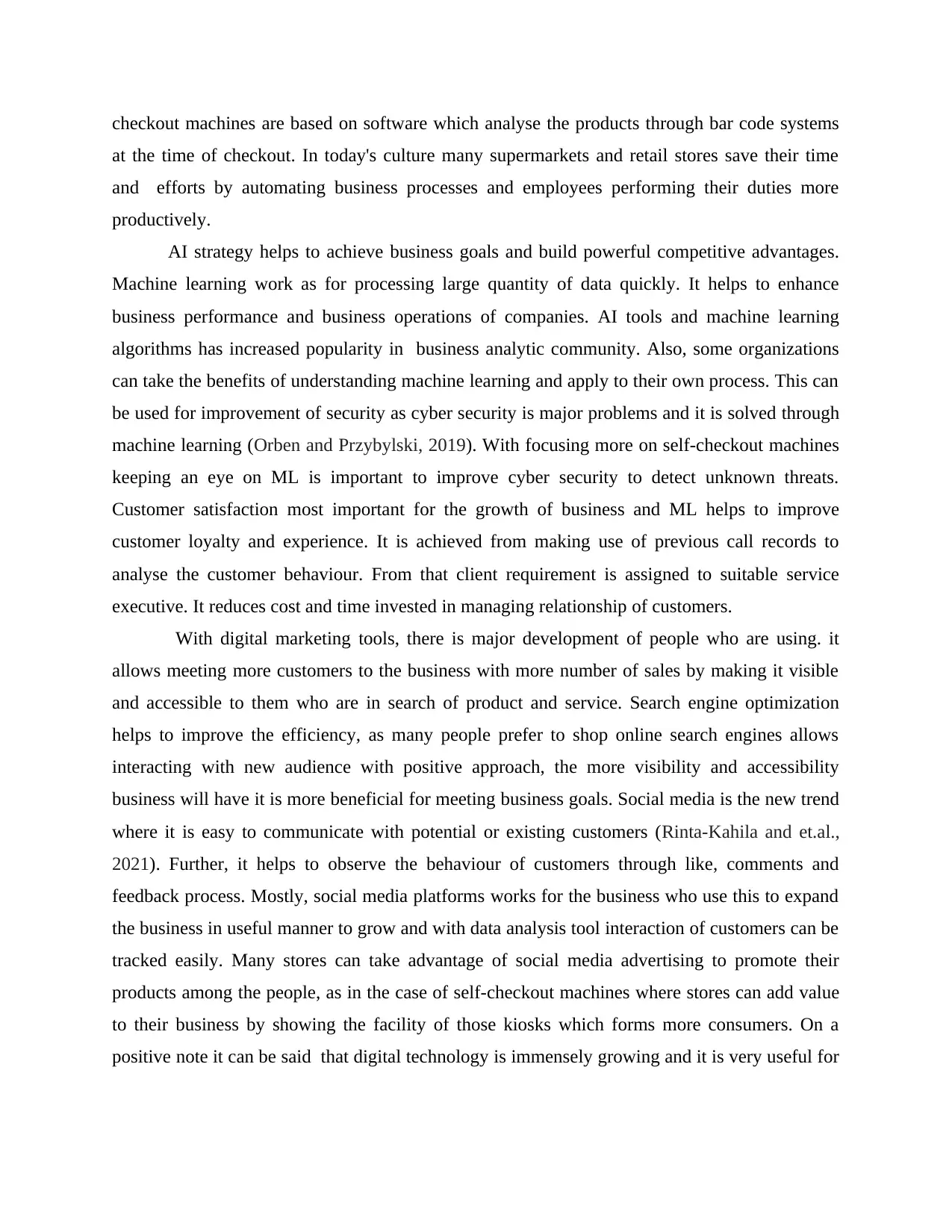
checkout machines are based on software which analyse the products through bar code systems
at the time of checkout. In today's culture many supermarkets and retail stores save their time
and efforts by automating business processes and employees performing their duties more
productively.
AI strategy helps to achieve business goals and build powerful competitive advantages.
Machine learning work as for processing large quantity of data quickly. It helps to enhance
business performance and business operations of companies. AI tools and machine learning
algorithms has increased popularity in business analytic community. Also, some organizations
can take the benefits of understanding machine learning and apply to their own process. This can
be used for improvement of security as cyber security is major problems and it is solved through
machine learning (Orben and Przybylski, 2019). With focusing more on self-checkout machines
keeping an eye on ML is important to improve cyber security to detect unknown threats.
Customer satisfaction most important for the growth of business and ML helps to improve
customer loyalty and experience. It is achieved from making use of previous call records to
analyse the customer behaviour. From that client requirement is assigned to suitable service
executive. It reduces cost and time invested in managing relationship of customers.
With digital marketing tools, there is major development of people who are using. it
allows meeting more customers to the business with more number of sales by making it visible
and accessible to them who are in search of product and service. Search engine optimization
helps to improve the efficiency, as many people prefer to shop online search engines allows
interacting with new audience with positive approach, the more visibility and accessibility
business will have it is more beneficial for meeting business goals. Social media is the new trend
where it is easy to communicate with potential or existing customers (Rinta-Kahila and et.al.,
2021). Further, it helps to observe the behaviour of customers through like, comments and
feedback process. Mostly, social media platforms works for the business who use this to expand
the business in useful manner to grow and with data analysis tool interaction of customers can be
tracked easily. Many stores can take advantage of social media advertising to promote their
products among the people, as in the case of self-checkout machines where stores can add value
to their business by showing the facility of those kiosks which forms more consumers. On a
positive note it can be said that digital technology is immensely growing and it is very useful for
at the time of checkout. In today's culture many supermarkets and retail stores save their time
and efforts by automating business processes and employees performing their duties more
productively.
AI strategy helps to achieve business goals and build powerful competitive advantages.
Machine learning work as for processing large quantity of data quickly. It helps to enhance
business performance and business operations of companies. AI tools and machine learning
algorithms has increased popularity in business analytic community. Also, some organizations
can take the benefits of understanding machine learning and apply to their own process. This can
be used for improvement of security as cyber security is major problems and it is solved through
machine learning (Orben and Przybylski, 2019). With focusing more on self-checkout machines
keeping an eye on ML is important to improve cyber security to detect unknown threats.
Customer satisfaction most important for the growth of business and ML helps to improve
customer loyalty and experience. It is achieved from making use of previous call records to
analyse the customer behaviour. From that client requirement is assigned to suitable service
executive. It reduces cost and time invested in managing relationship of customers.
With digital marketing tools, there is major development of people who are using. it
allows meeting more customers to the business with more number of sales by making it visible
and accessible to them who are in search of product and service. Search engine optimization
helps to improve the efficiency, as many people prefer to shop online search engines allows
interacting with new audience with positive approach, the more visibility and accessibility
business will have it is more beneficial for meeting business goals. Social media is the new trend
where it is easy to communicate with potential or existing customers (Rinta-Kahila and et.al.,
2021). Further, it helps to observe the behaviour of customers through like, comments and
feedback process. Mostly, social media platforms works for the business who use this to expand
the business in useful manner to grow and with data analysis tool interaction of customers can be
tracked easily. Many stores can take advantage of social media advertising to promote their
products among the people, as in the case of self-checkout machines where stores can add value
to their business by showing the facility of those kiosks which forms more consumers. On a
positive note it can be said that digital technology is immensely growing and it is very useful for
⊘ This is a preview!⊘
Do you want full access?
Subscribe today to unlock all pages.

Trusted by 1+ million students worldwide
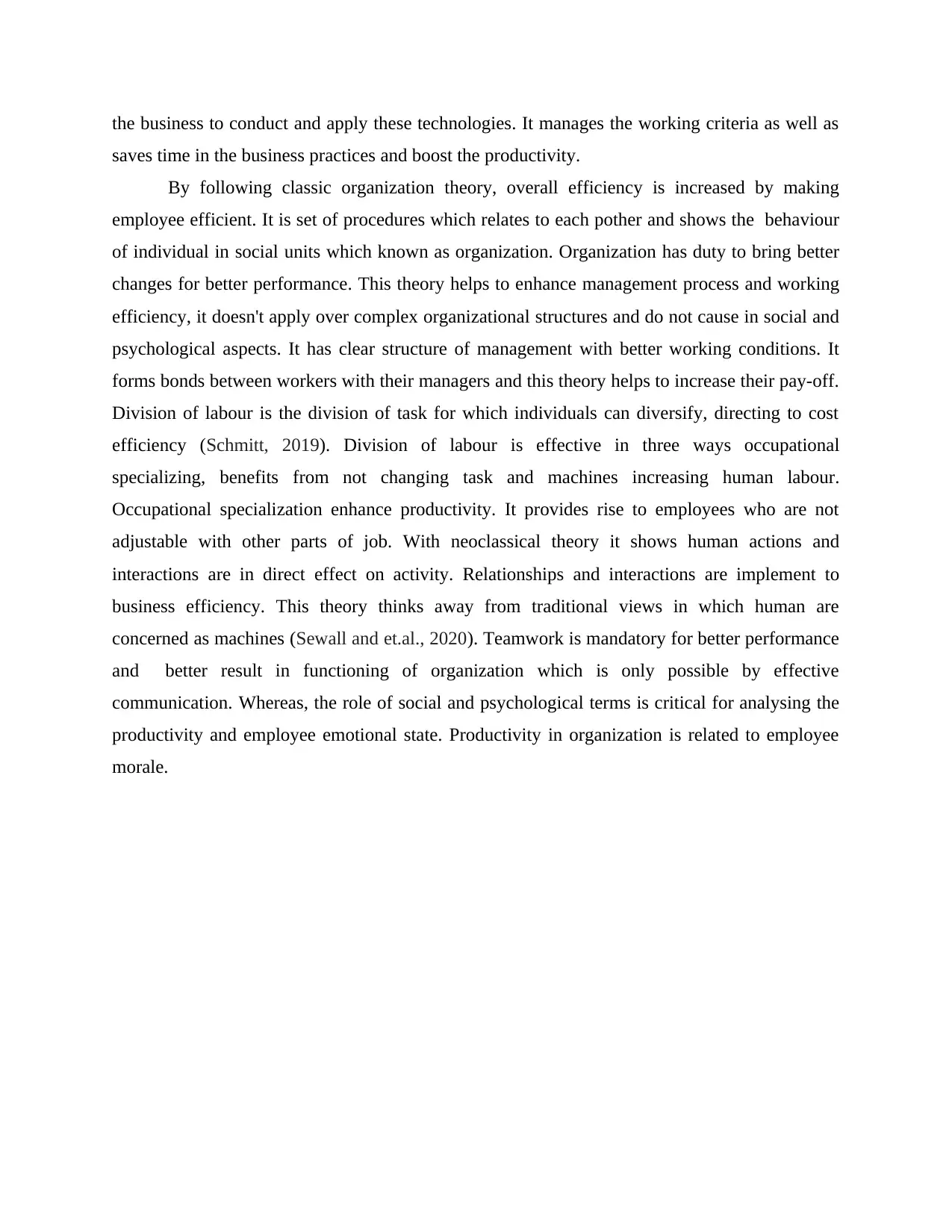
the business to conduct and apply these technologies. It manages the working criteria as well as
saves time in the business practices and boost the productivity.
By following classic organization theory, overall efficiency is increased by making
employee efficient. It is set of procedures which relates to each pother and shows the behaviour
of individual in social units which known as organization. Organization has duty to bring better
changes for better performance. This theory helps to enhance management process and working
efficiency, it doesn't apply over complex organizational structures and do not cause in social and
psychological aspects. It has clear structure of management with better working conditions. It
forms bonds between workers with their managers and this theory helps to increase their pay-off.
Division of labour is the division of task for which individuals can diversify, directing to cost
efficiency (Schmitt, 2019). Division of labour is effective in three ways occupational
specializing, benefits from not changing task and machines increasing human labour.
Occupational specialization enhance productivity. It provides rise to employees who are not
adjustable with other parts of job. With neoclassical theory it shows human actions and
interactions are in direct effect on activity. Relationships and interactions are implement to
business efficiency. This theory thinks away from traditional views in which human are
concerned as machines (Sewall and et.al., 2020). Teamwork is mandatory for better performance
and better result in functioning of organization which is only possible by effective
communication. Whereas, the role of social and psychological terms is critical for analysing the
productivity and employee emotional state. Productivity in organization is related to employee
morale.
saves time in the business practices and boost the productivity.
By following classic organization theory, overall efficiency is increased by making
employee efficient. It is set of procedures which relates to each pother and shows the behaviour
of individual in social units which known as organization. Organization has duty to bring better
changes for better performance. This theory helps to enhance management process and working
efficiency, it doesn't apply over complex organizational structures and do not cause in social and
psychological aspects. It has clear structure of management with better working conditions. It
forms bonds between workers with their managers and this theory helps to increase their pay-off.
Division of labour is the division of task for which individuals can diversify, directing to cost
efficiency (Schmitt, 2019). Division of labour is effective in three ways occupational
specializing, benefits from not changing task and machines increasing human labour.
Occupational specialization enhance productivity. It provides rise to employees who are not
adjustable with other parts of job. With neoclassical theory it shows human actions and
interactions are in direct effect on activity. Relationships and interactions are implement to
business efficiency. This theory thinks away from traditional views in which human are
concerned as machines (Sewall and et.al., 2020). Teamwork is mandatory for better performance
and better result in functioning of organization which is only possible by effective
communication. Whereas, the role of social and psychological terms is critical for analysing the
productivity and employee emotional state. Productivity in organization is related to employee
morale.
Paraphrase This Document
Need a fresh take? Get an instant paraphrase of this document with our AI Paraphraser

CONCLUSION
By this essay of self-checkout machines it has been concluded about their importance and
the development, where it shows how it affects the working efficiency. In further discussing it
had been found that how this technology are being used in businesses and their technological
platform and software. Apart from that it also highlights about the technology which is used by
various types of business and the effective use of technology. At last, it analysed about digital
technology with their benefits in the organization and the newly immerse growth of digital
technology for more beneficial terms. There are theories linked up with the technology in terms
of advantages.
By this essay of self-checkout machines it has been concluded about their importance and
the development, where it shows how it affects the working efficiency. In further discussing it
had been found that how this technology are being used in businesses and their technological
platform and software. Apart from that it also highlights about the technology which is used by
various types of business and the effective use of technology. At last, it analysed about digital
technology with their benefits in the organization and the newly immerse growth of digital
technology for more beneficial terms. There are theories linked up with the technology in terms
of advantages.
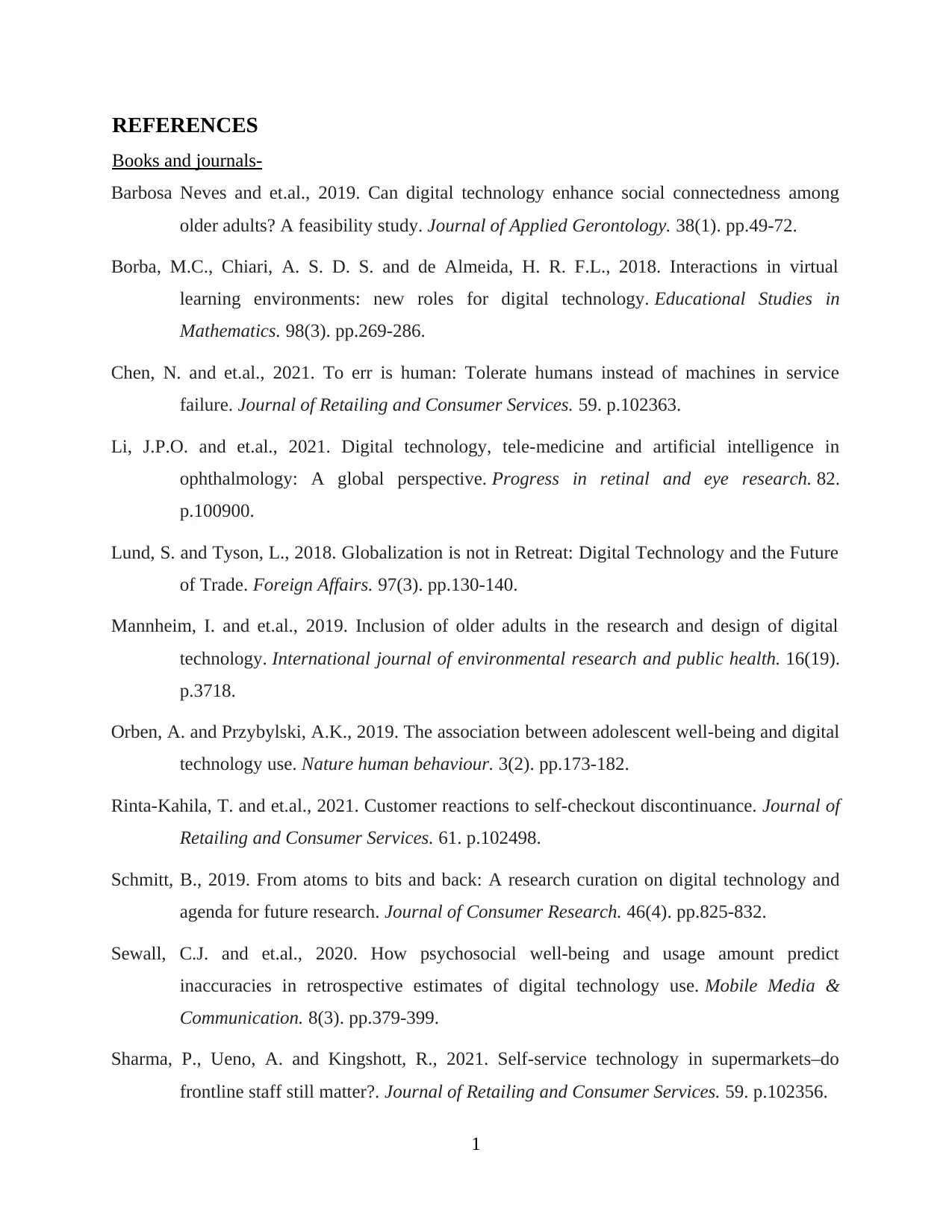
REFERENCES
Books and journals-
Barbosa Neves and et.al., 2019. Can digital technology enhance social connectedness among
older adults? A feasibility study. Journal of Applied Gerontology. 38(1). pp.49-72.
Borba, M.C., Chiari, A. S. D. S. and de Almeida, H. R. F.L., 2018. Interactions in virtual
learning environments: new roles for digital technology. Educational Studies in
Mathematics. 98(3). pp.269-286.
Chen, N. and et.al., 2021. To err is human: Tolerate humans instead of machines in service
failure. Journal of Retailing and Consumer Services. 59. p.102363.
Li, J.P.O. and et.al., 2021. Digital technology, tele-medicine and artificial intelligence in
ophthalmology: A global perspective. Progress in retinal and eye research. 82.
p.100900.
Lund, S. and Tyson, L., 2018. Globalization is not in Retreat: Digital Technology and the Future
of Trade. Foreign Affairs. 97(3). pp.130-140.
Mannheim, I. and et.al., 2019. Inclusion of older adults in the research and design of digital
technology. International journal of environmental research and public health. 16(19).
p.3718.
Orben, A. and Przybylski, A.K., 2019. The association between adolescent well-being and digital
technology use. Nature human behaviour. 3(2). pp.173-182.
Rinta-Kahila, T. and et.al., 2021. Customer reactions to self-checkout discontinuance. Journal of
Retailing and Consumer Services. 61. p.102498.
Schmitt, B., 2019. From atoms to bits and back: A research curation on digital technology and
agenda for future research. Journal of Consumer Research. 46(4). pp.825-832.
Sewall, C.J. and et.al., 2020. How psychosocial well-being and usage amount predict
inaccuracies in retrospective estimates of digital technology use. Mobile Media &
Communication. 8(3). pp.379-399.
Sharma, P., Ueno, A. and Kingshott, R., 2021. Self-service technology in supermarkets–do
frontline staff still matter?. Journal of Retailing and Consumer Services. 59. p.102356.
1
Books and journals-
Barbosa Neves and et.al., 2019. Can digital technology enhance social connectedness among
older adults? A feasibility study. Journal of Applied Gerontology. 38(1). pp.49-72.
Borba, M.C., Chiari, A. S. D. S. and de Almeida, H. R. F.L., 2018. Interactions in virtual
learning environments: new roles for digital technology. Educational Studies in
Mathematics. 98(3). pp.269-286.
Chen, N. and et.al., 2021. To err is human: Tolerate humans instead of machines in service
failure. Journal of Retailing and Consumer Services. 59. p.102363.
Li, J.P.O. and et.al., 2021. Digital technology, tele-medicine and artificial intelligence in
ophthalmology: A global perspective. Progress in retinal and eye research. 82.
p.100900.
Lund, S. and Tyson, L., 2018. Globalization is not in Retreat: Digital Technology and the Future
of Trade. Foreign Affairs. 97(3). pp.130-140.
Mannheim, I. and et.al., 2019. Inclusion of older adults in the research and design of digital
technology. International journal of environmental research and public health. 16(19).
p.3718.
Orben, A. and Przybylski, A.K., 2019. The association between adolescent well-being and digital
technology use. Nature human behaviour. 3(2). pp.173-182.
Rinta-Kahila, T. and et.al., 2021. Customer reactions to self-checkout discontinuance. Journal of
Retailing and Consumer Services. 61. p.102498.
Schmitt, B., 2019. From atoms to bits and back: A research curation on digital technology and
agenda for future research. Journal of Consumer Research. 46(4). pp.825-832.
Sewall, C.J. and et.al., 2020. How psychosocial well-being and usage amount predict
inaccuracies in retrospective estimates of digital technology use. Mobile Media &
Communication. 8(3). pp.379-399.
Sharma, P., Ueno, A. and Kingshott, R., 2021. Self-service technology in supermarkets–do
frontline staff still matter?. Journal of Retailing and Consumer Services. 59. p.102356.
1
⊘ This is a preview!⊘
Do you want full access?
Subscribe today to unlock all pages.

Trusted by 1+ million students worldwide

Straker, L. and et.al., 2018. Conflicting guidelines on young children's screen time and use of
digital technology create policy and practice dilemmas. The Journal of pediatrics. 202.
pp.300-303.
Zelizer, B., 2019. Why journalism is about more than digital technology. Digital
journalism. 7(3). pp.343-350.
2
digital technology create policy and practice dilemmas. The Journal of pediatrics. 202.
pp.300-303.
Zelizer, B., 2019. Why journalism is about more than digital technology. Digital
journalism. 7(3). pp.343-350.
2
1 out of 10
Related Documents
Your All-in-One AI-Powered Toolkit for Academic Success.
+13062052269
info@desklib.com
Available 24*7 on WhatsApp / Email
![[object Object]](/_next/static/media/star-bottom.7253800d.svg)
Unlock your academic potential
Copyright © 2020–2025 A2Z Services. All Rights Reserved. Developed and managed by ZUCOL.




